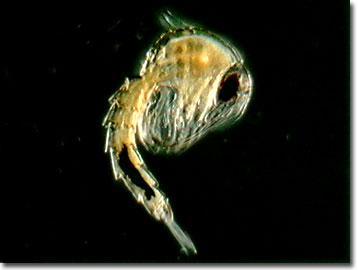Darkfield Digital Image Gallery
Mosquito Pupa
As with many other insect species, mosquitoes in the genus Culex undergo several life stages between the egg and maturity. Because of their hard, chitinous exoskeletons, insects are forced to molt as they grow. In the dramatic transformation from an aquatic larva to a flying adult, the mosquito undergoes an intermediate pupal stage.

With the mosquito, the pupa is a resting, non-feeding life stage. As a pupa, it takes about two days for the dipteran to transform into a fully developed winged adult. When development is complete, the pupal skin splits and the adult mosquito emerges. At first, the adults rest on the water surface, awaiting the hardening of body parts and the spreading and drying of paired wings before they are ready to fly and seek mates. It is at the time of emergence that mosquitoes found in bodies of water containing fish are particularly vulnerable to predation. However, the large numbers of offspring help offset the feeding frenzies by fishes and birds, such as the beloved purple martin.
Mosquito pupae, known also as "tumblers," are often observed at the air-water interface, suspended below the surface film. Breathing is accomplished via a pair of breathing tubes known as trumpets that are extended into the atmosphere and connect to the tracheal breathing system. If disturbed, the pupa is capable of some limited locomotion and will jerk and tumble down into decaying matter in the pond or lake bed. Buoyant, the pupa floats back to the surface when relaxed and no threat is detected. The timing of development, from the aquatic larval stage to the pupa and emerging as an adult, depends on the species and environmental factors. At cooler temperatures, the life stages and maturation are extended. For example, Culex tarsalis, a common California mosquito takes 10 days at 80 degrees Fahrenheit to go from egg to reproducing adult, while at 70 degrees Fahrenheit, the life cycle is extended to two weeks. The pupal stage takes from 1 to 4 days, depending upon the species and water temperature.
Contributing Authors
Cynthia D. Kelly, Thomas J. Fellers and Michael W. Davidson - National High Magnetic Field Laboratory, 1800 East Paul Dirac Dr., The Florida State University, Tallahassee, Florida, 32310.
BACK TO THE DARKFIELD IMAGE GALLERY
BACK TO THE DIGITAL IMAGE GALLERIES
Questions or comments? Send us an email.
© 1995-2025 by Michael W. Davidson and The Florida State University. All Rights Reserved. No images, graphics, software, scripts, or applets may be reproduced or used in any manner without permission from the copyright holders. Use of this website means you agree to all of the Legal Terms and Conditions set forth by the owners.
This website is maintained by our
Graphics & Web Programming Team
in collaboration with Optical Microscopy at the
National High Magnetic Field Laboratory.
Last Modification Friday, Nov 13, 2015 at 01:19 PM
Access Count Since September 17, 2002: 14208
Visit the website of our partner in introductory microscopy education:
|
|
